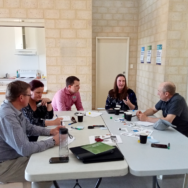📖 Reading time: 5 mins 30 secs
Right now, we are working on fine-tuning our Change Capability Framework. The goal is to create a simple model matching our Leadership, Project Management and Change Management practices.
Contents
During a meeting, our CEO asked: "What do we need to embrace and make change happen, no matter what the change is or the time?"
Once we know that, we can sweeten the learning pathway for every player in the business transformation process. It is obvious that whether you are a Change Champion or Change Leader, if you don't know change yet, you must start with the Change Management Fundamentals.
The First Step to Successful Change Management
Let's take the first step together. Repeat after me: "Change is inevitable." And in fact, humans and businesses need to embrace change if they want to evolve, progress, innovate and grow. If you don't, you go the way Dinosaurs went. And the rest is history.
The problem with change is that we don't always find change invigorating. More often, we find it uncomfortable or even threatening. Because organisational change success depends on individuals (that's you) engaging and supporting the change, Change Management has risen in popularity. Most CEOs see Change Management as one of the most crucial organisational capabilities to invest in.
OK, so what is Change Management, you may ask. Change Management is a profession and a skill. Change Managers manage the transformation process. They aim to minimise the challenges associated with introducing new ways of working. As change experts, they use techniques and best practices to engage stakeholders, overcome resistance, communicate changes and equip people to adopt new ways.
The Change Process - Just Like Learning to Walk
What does a change process typically look like? The change management process begins by understanding the here and now. Think about what your business will be like after the change. The process continues with planning the required activities to implement changes, including how we engage and support the stakeholders to learn and grow. Most projects depend on people adjusting their way of working. Change success is defined not only by the successful project execution but also by the realised benefits and the avoidance of negative side effects. Change Managers like to joke that they did a good job if no one noticed that things changed for the better.
Imagine a newborn. Like all babies, this one still needs to learn to crawl and walk to explore her world.
In the same way, having a vision, transitioning and making changes is like babies learning to walk. Change needs time. Organisations and people need patience to grow. You are more likely to embrace change if you expect to stumble before you jump around like a happy toddler.


Want some FREE Tools? Sign up to The 6 Cents of Change
And get Free Change Management Tips for Managers - Straight to your inbox before anyone else.
The Struggles of Change Management and The Leaning Tower of Pisa: A Comparison
But what if you neither are nor have a Change Manager? Do you still need to read on? Yes, Change Management is a critical leadership skill and organisational capability. Change Management demands understanding people, culture and what drives your organisation forward. To answer Sam's question: For employees to be ready and capable of managing change, we need emotional intelligence, communication skills, conflict-resolution strategies, and resistance-handling techniques.
Everybody benefits from Change Management. WA Safe Work makes change everybody's responsibility. Poorly managed organisational change can hurt people's minds and bodies. And organisations are likely to risk safety, financials and reputation if they don't invest here.
Let's time-travel to the 12th century. A team of builders were asked to create the most magnificent tower. But instead of laying a solid foundation for their project, they grew eager and rushed to start building the columns and walls.
They focussed on speed and the deliverable. But soon, their mistake became obvious. On soft grounds, the tower of Pisa began to lean already during construction, delaying its completion and jeopardising its original intent to swing seven marvellous bells. Luckily it still stands at an almost 4% tilt, making it a famous tourist attraction and serving as a great reminder of the value of a solid foundation and structure.
This is the rather painful lesson a failed change project teaches the involved and impacted stakeholders. Instead of jumping straight to execution, we must integrate a reliable Change Management Strategy with the Project Management plan. This is how we get over 100,000 people safely from A to B, like the 1.6km Golden Gate Bridge connecting San Francisco Bay with the Marin Peninsula.
The Power of Change Leaders and Change Champions: Guiding Teams Through Transitions
"Ok, so who needs these Change Basics?" asks Sam as he walks to the whiteboard to make a point. You know, organisational change is complex because there are many players involved. We typically count Project Managers and Change Managers, who often come equipped. Then we also have the project sponsor, a group of senior and middle management change leaders and a cohort of change champions to consider. If your organisation isn't doing change well, chances are that these players have not spent enough effort understanding change management and its benefits for your business or they tried but didn't find the right way to get started.
The project sponsor is usually a top-level executive. As the project's figurehead, they inspire employees with their vision and business strategy. Ideally, they symbolise the calm in the storm, the rock, and job security.
Just as doctors provide advice and medical expertise to their patients, change leaders guide employees through transitions. By their qualified assessment of current operations, aka BAU and their people, they prioritise and prescribe actions that bring about positive change. Like doctors, change leaders specialise in local business areas. Employees look to their leaders for protection, answers and help in trialling and embracing new ways of working. A good change leader uses their deep understanding of the organisation's culture, operations and people to balance stable operations and continuous improvement.
Just as a doctor will provide patients with the best advice available to achieve good health, change leaders give teams the information and direction necessary to create an environment of sustained growth.
It is important to remember that sustained growth is not always a direct path. Picture an AFL player. During a game, he suffered a serious leg injury. He needed surgery and extensive rehabilitation. To recover, he was assigned a buddy to help him get used to his new leg. At first, the athlete was very resistant to the changes and felt uncomfortable and unfamiliar with his leg muscles.
Guess what? This blog is inspired by our Speed Mentoring Change Conversation Starter Cards.
I pulled the card: "What skills help you manage and learn change?" and Sam pulled "We need to leave our comfort zone to change. How do you build a learning culture/habit?" and boom, the ideas just kept on coming. 15 minutes later, we agreed that you need to be privy to what we've learned. Watch this video to find out more innovative and fun ways to use the cards to excite your colleagues to change. Don't have the cards yet? Head over to our shop to get your deck, today.
He worked with his buddy, slowly changing his training habits and rebuilding his confidence to continue playing the sport he loved. With time, the athlete started to get used to the changes and was eventually playing at a higher level than before. Besides more agility, he was amazed at the resilience he gained through this experience.
This story perfectly illustrates the value of Change Champions in motivating others to change. His buddy had lived through a similar experience and understood how uncomfortable the athlete was with the uncertainty about his future. Together they worked through the changes step by step. Change Champions are equals that listen to colleagues, facilitate the change conversation and encourage others to change. They need to understand the psychology of change to turn resistance into engagement. We know from Gartner's extensive research that projects high in engagement are adopted two-thirds faster and achieve better outcomes. So, it is obvious that investing in Emotional Intelligence and a Growth Mindset will pay back.
You see, Change Management helps an organisation to change when everyone involved understands how the transition works. Just like building a tower, if you don't lay the foundation, it will be unstable. Managers become change leaders and like doctors, they help guide teams through changes and make sure everybody is ready for the new ways. Change can feel uncomfortable at first but with time and Change Champions to support, people can learn agility and resilience. A basic understanding of the psychology of change and a Growth Mindset makes it easier for everyone to embrace progress and move forward.

Eva is one of the masterminds behind Approach Services' blog and The 6 Cents of Change. She is an innovator, trainer and change manager. Her work has been published in the Schmalenbach Journal of Business Research. In her spare time, she enjoys camping with her two little boys and permaculture gardening.
Subscribe to our monthly newsletter The 6 Cents of Change and follow us on LinkedIn to learn more!

 (08) 6102 0343
(08) 6102 0343







